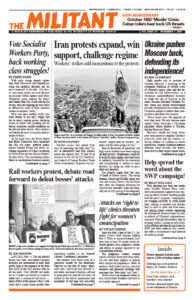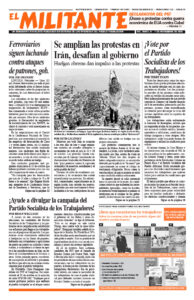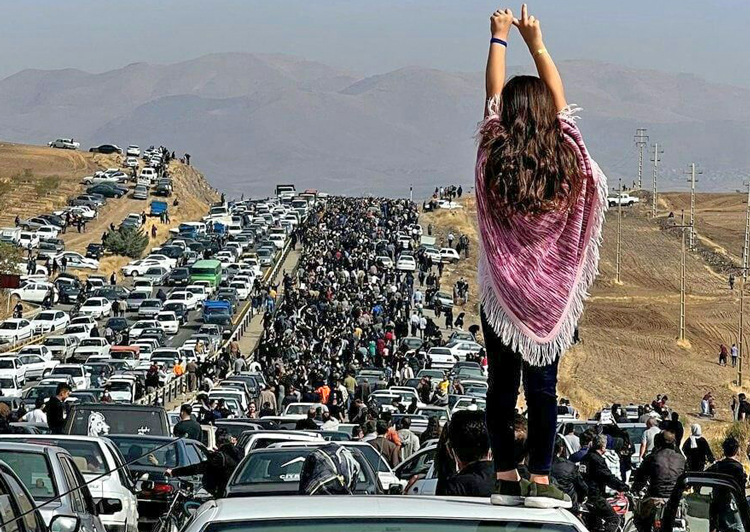Teachers across Iran joined three days of mourning and then held “sit-ins” at elementary and high schools across the country Oct. 23 and 24 in response to the call by the Coordinating Council of Iranian Teachers Trade Union Associations “to protest the systematic suppression of teachers, students and the noble people of Iran.”
Tens of thousands of university and high school students have been stepping up their protests. Shopkeepers, especially in the Kurdish region, shut their doors in solidarity. Inspired by the movement and strengthening it, workers at more factories are going on strike to press their own demands.
The protests began after the Sept. 16 death of Mahsa Amini. The young woman, whose real Kurdish name was Jina, was visiting Tehran. She died three days after she collapsed following her arrest by the “morality” police for allegedly not strictly hewing to the obligatory dress code. Few believe the official story that her death was from an underlying medical condition.
Her death unleashed pent-up anger over the oppression of women; abusive conditions faced by oppressed nationalities, like Kurds; brutal repression of those who stand in the rulers’ way; discrimination against Sunni Muslims by the Shiite-based government; the deteriorating economic conditions; and the price paid by working people who are used as cannon fodder by the bourgeois clerical regime in its reactionary military adventures across the region.
In an attempt to crush the protests, which have spread to every province and more than 100 cities, the regime has arrested thousands. It has sent the police, the Islamic Revolutionary Guard Corps and paramilitary Basij thugs to attack protesters. It’s lobbed tear gas, rubber bullets and paintballs and used live ammunition — especially in regions where oppressed minorities live — killing dozens, including at least 14 students. But it has failed to quell the actions.
Worker, student ties
Common bonds between students and the labor movement are especially worrisome for the regime. On Oct. 17 two students at Persian Gulf University in the port city of Bushehr were arrested after joining other students in a protest in support of oil workers on strike in the mostly Arab town of Asalouye.
On Oct. 22, workers at the Aidin Chocolate factory in Tabriz in the Azerbaijan region went on strike. Three days later workers at the Tabriz Motorsazan Tractor Manufacturing Company walked off the job, demanding wage increases and opposing speedup.
The union of workers on strike at the Haft Tappeh sugar cane mill in Khuzestan issued a statement Oct. 23 saying, “Today, the street, school and university are tied together.” The union saluted the “fighting girls and boys who shook the world with the slogan of women, life and freedom.”
Today’s actions stand on the shoulders of earlier protests. At the end of 2017 and into 2018 working people in cities, small towns and rural areas took to the streets in the face of the bitter toll of Tehran’s wars across the Middle East and the deepening economic and social crisis. Widespread protests broke out again in 2019, drawing both men and women, and working people from all the country’s religions and nationalities.
Students: End segregated dining
Tasnim, a pro-Islamic Republic news service, reported that the student Islamic Association gave a letter to authorities at Tehran’s Sharif University of Technology demanding that segregation in campus dining for men and women be ended. The school had just reopened after an Oct. 3 attack by Basij thugs on protesters there. Not waiting for an answer, female students entered the men’s dining hall Oct. 22. University officials then closed the dining room.
In a daring action widely covered in the Iranian press, male and female students then sat down together outside to share their meal. Tasnim claimed this was “abnormal behavior” and “a desecration.” But the World of the Economy, an Iranian daily, called it an “interesting” incident where the students ate “like a family.” Conflicting reports in major daily papers are one sign of rifts in capitalist ruling circles.
Students at other universities soon followed suit, including at Beheshti University in Tehran, where students pushed back an attempt by the Basij to prevent a joint meal.
At Hakim Sabzevar University in Khorasan province in northeastern Iran, the lunchroom erupted into cheers and chants of “Freedom, freedom, freedom” as women marched into the men’s section. One student wrote, “How long have we been waiting for this moment.”
Over the last week the regime has started sending Ali Bahadori Jahromi, the official spokesman of the Council of Ministers, to campuses to try to win students to back the regime. To no avail.
On Oct. 24, Bahadori was unable to finish his speech at Khaje Nasir University in Tehran over the sound of students chanting “Women, life, freedom.” Bahadori said he welcomed the slogan and called on the audience to chant it with him. The students then began chanting “Down with the dictator,” and demanded the release of a student activist who was arrested during an earlier protest. Bahadori claimed he didn’t know anything about it.
On Oct. 25, Bahadori was shouted down at Qom University. The city of Qom is home to many Shiite religious leaders. In a packed auditorium students chanted, “We don’t want murderous guests, we don’t want a corrupt system.”
Having met with small groups of pro-regime students, Bahadori cancelled further public events there.
The regime has also slandered protesters, claiming they are U.S. or Israeli agents or want to bring back the rule of the U.S.-backed dictatorship of Shah Reza Pahlavi, who was overthrown by the 1979 Iranian Revolution.
Two students in Tehran responded with a video where they held up pictures of Iranian President Ebrahim Raisi, Ayatollah Ali Khamenei and the deposed shah. Then they proceeded to rip up all three.


